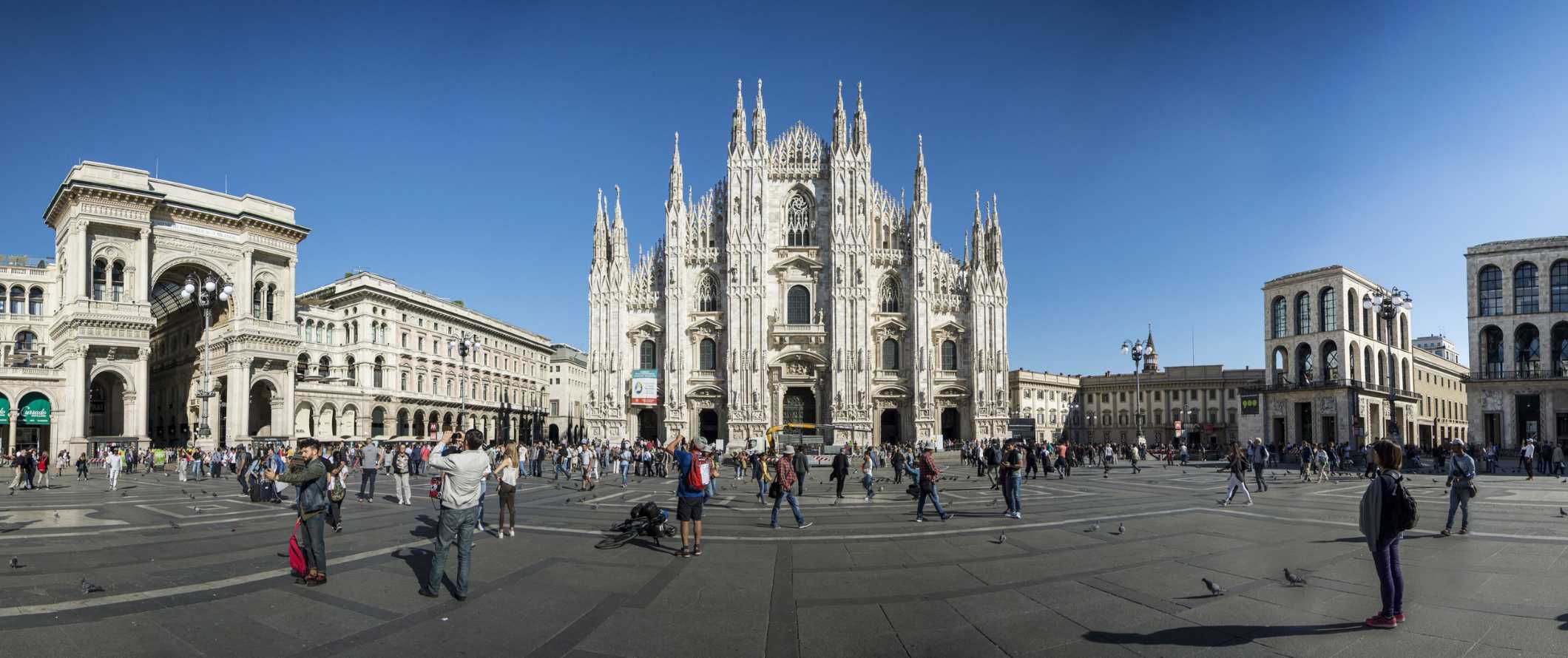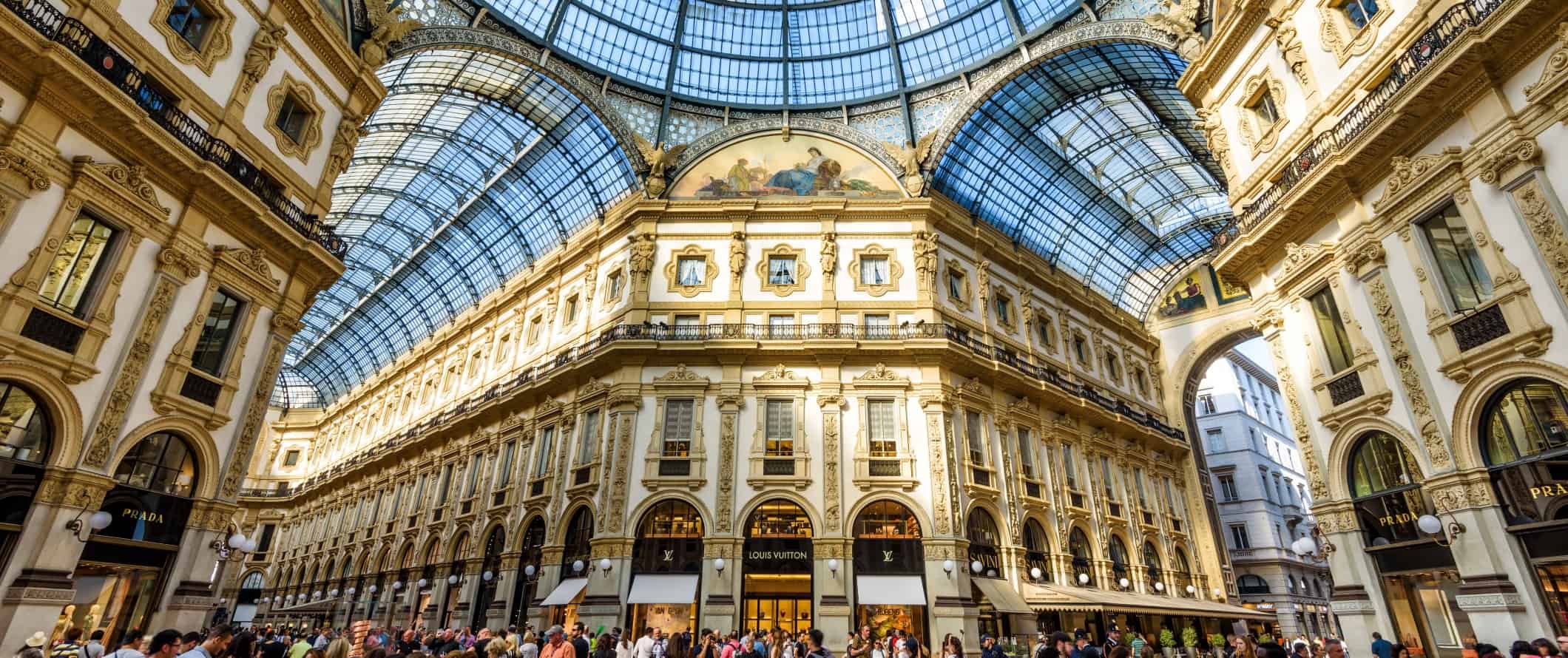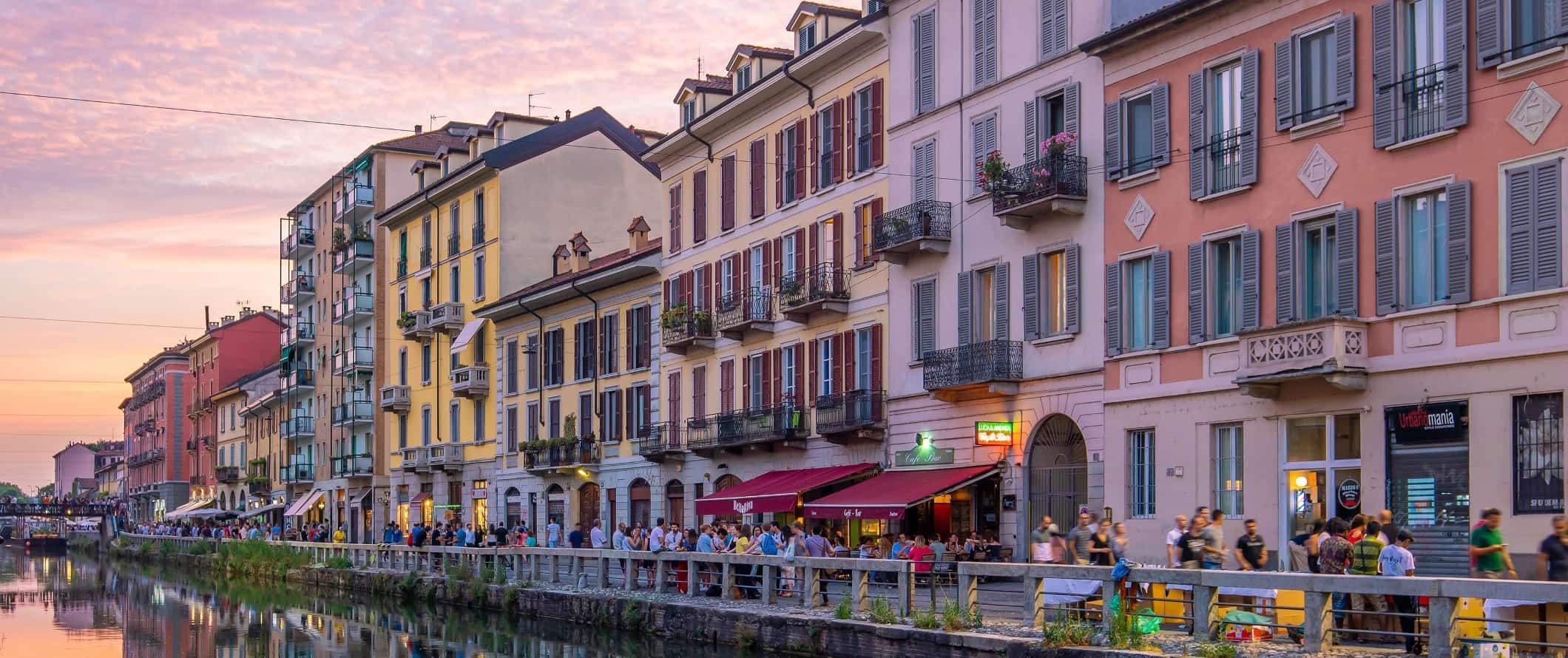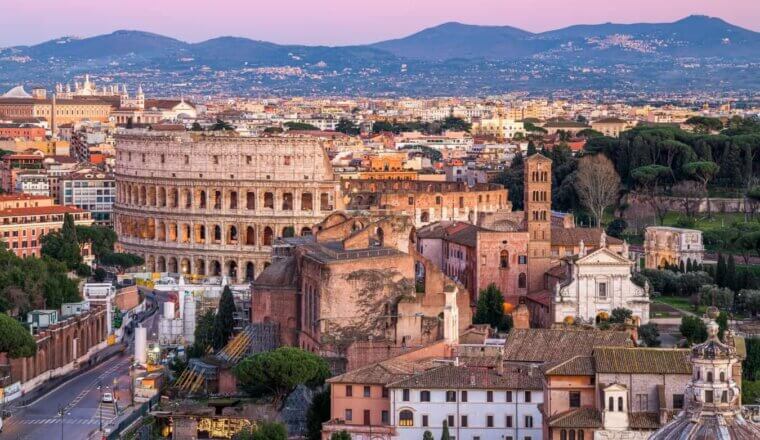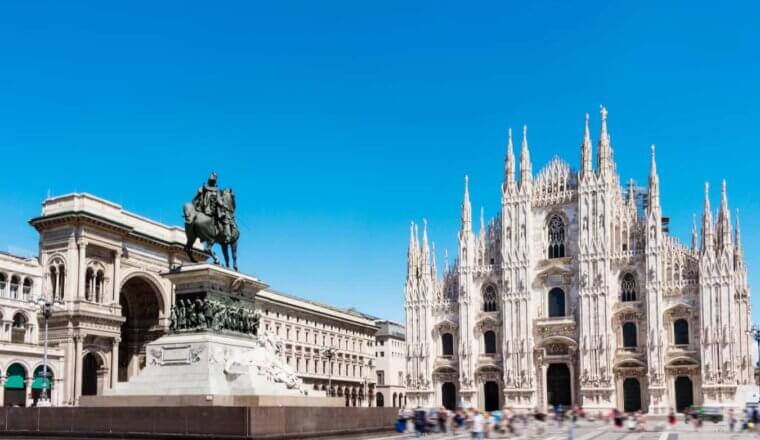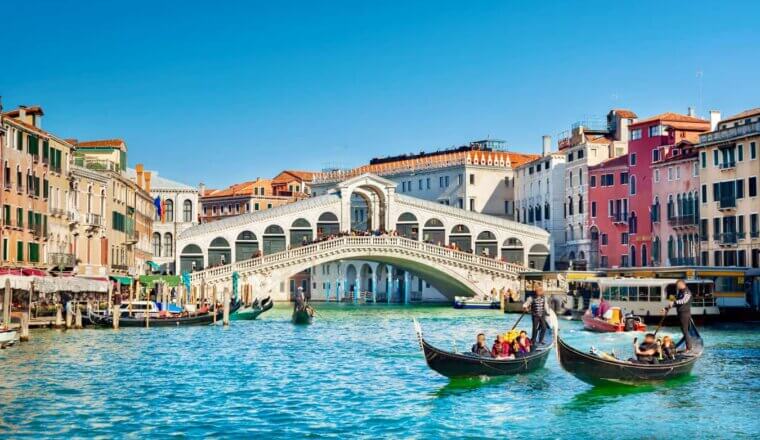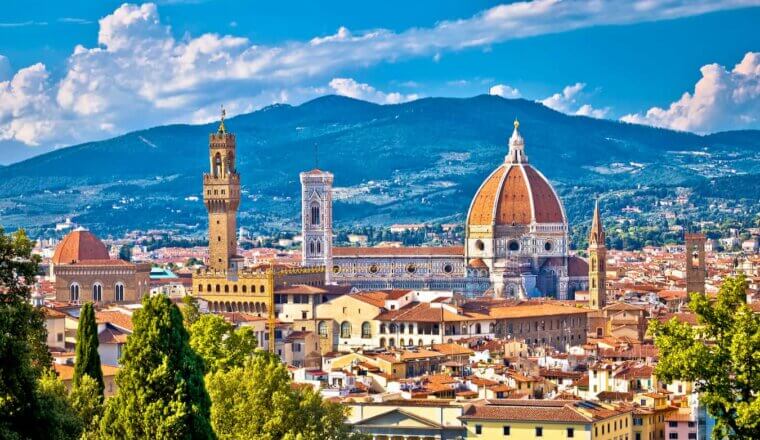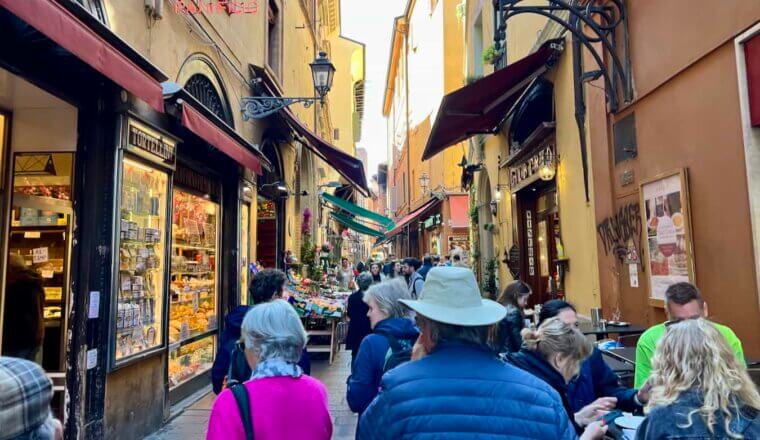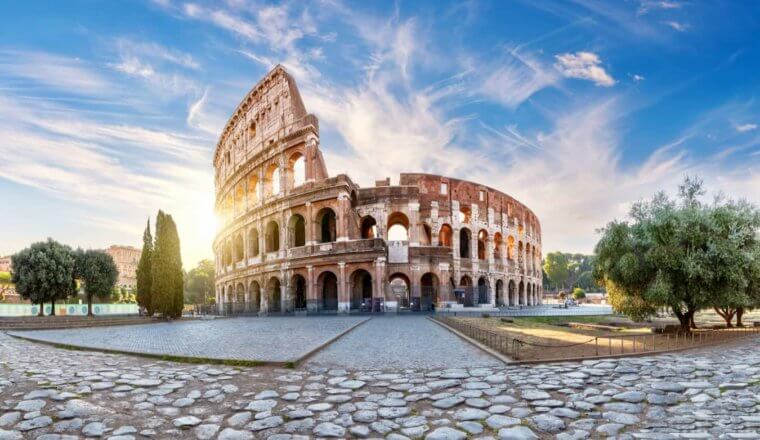Milan is recognized worldwide as one of the four design and fashion capitals of the world. It’s also a business hub, as the location of Italy’s stock exchange and third wealthiest EU city (after Paris and Madrid).
As the second-largest city in Italy (and home to the second-largest airport in the country), it’s a popular destination for travelers as it’s easy to get to.
But Milan has a lot for travelers to see and do beyond fashion. The city used to be the capital of the Western Roman Empire and was an influential city during the Italian Renaissance. There’s the beautiful Milan Cathedral and Sforzesco Castle, a 15th-century castle that houses Michelangelo’s last sculpture. Then there’s Leonardo da Vinci’s The Last Supper, located inside Santa Maria delle Grazie church. In short, Milan has no shortage of history and culture to bask in.
While it’s no Rome or Florence, Milan is still worth a few nights (maybe longer if you’re looking to enjoy the glitzy, fashionista side of the city).
This travel guide Milan travel guide to help you plan your trip, save money, and make the most out of your time in this fashion-forward metropolis.
Table of Contents
Top 5 Things to See and Do in Milan
1. Visit the Duomo
With over 3,500 statues, 135 spires, and five bronze doors, Milan’s cathedral is the largest church in Italy and the third-largest in the world. It’s not surprising that it took over 500 years to complete, with construction starting in 1386 and finishing in 1965. Be sure to admire the view from the top; it’s one of the best in the city. Access to the cathedral and museum is 7 EUR while adding access to the archaeological site and rooftop costs 15 EUR if you take the stairs and 20 EUR via elevator. Skip the line tickets with access to the terrace at 33 EUR.
2. Relax in Parco Sempione
Parco Sempione is Milan’s most famous city park, a vast oasis of green space spanning over 38 hectares (95 acres). Designed in the 19th century emulating English romantic gardens, the park is home to the Sforzesco Castle, an aquarium, an amphitheater, Triennale di Milano (a design and art museum), Branca Tower, and a handful of bars and cafes. This is a tranquil place to wander for hours or to sit and have a picnic in the grass. The entire park also has free Wi-Fi if you need to get connected.
3. Explore Sforzesco Castle
Built in the 15th century, this castle was one of the largest citadels in Europe during the 16th-17th centuries. It houses 12 museums and a vast archive of artifacts. Two noteworthy museums include the Museum of Ancient Art, with its armory and tapestry collection, and the Museum Pietà Rondanini, which includes Michelangelo’s last completed sculpture (Rondanini Pietà, completed in 1564). The castle entrance is free, but admission to all of the museums costs 5 EUR. A three-day museum pass for all the museums is 12 EUR.
4. Admire the Last Supper
This 15th-century Leonardo da Vinci masterpiece resides in the church of Santa Maria delle Grazie, which is often just referred to as The Last Supper Museum. The Last Supper, completed around 1498, is remarkably well preserved and historians still haven’t solved all its mysteries. You must book a reserved 15-minute time slot, with tickets going on sale 2-3 months in advance. As one of the most famous paintings in the world, tickets sell out almost as soon as they go on sale, so this is definitely one to plan ahead for. Tickets cost 15 EUR while guided tours with Get Your Guide cost 56 EUR
5. Watch some football
If you’re a football (soccer) fan, book yourself tickets to a match at San Siro stadium. Milan is home to two of the world’s best football teams: AC Milan and Inter Milan. Games are super lively and a great way to connect with locals. With a capacity of 80,000 spectators, this is the largest stadium in Italy and where the 2026 Winter Olympics opening ceremony will take place. Tickets start at 20-30 EUR. When matches aren’t taking place, you can take a guided tour of the stadium and visit the museum for 30 EUR.
Other Things to See and Do in Milan
1. Take a walking tour
One of the best ways to get to know Milan is to walk around it with a local. You’ll get your bearings, a history lesson, and see the main highlights as you explore. For free walking tours, check out Citywalkers. Their tours cover the main sights and are perfect for budget travelers. Just be sure to tip your guide at the end.
If you’re looking for more in-depth tour of the Last Supper and Duomo, check out Take Walks. They run the best paid tours in the city.
2. See Leonardo’s Horse
Located in the Piazella Dello Sporto, Leonardo’s Horse is one of the world’s largest bronze equine statues. Created by Nina Akamu in the 1990s, the design is based entirely on Leonardo da Vinci’s sketches from when he was commissioned by the Duke of Milan Ludovico il Moro in 1482. da Vinci was meant to create the world’s largest bronze horse statue dedicated to the Duke’s father, Francesco, but it was never completed. The horse stands over 24-feet tall and weighs 15 tons.
3. Roam the flea markets
While Milan is renowned for its high-end fashion and designer labels, it is also home to its fair share of flea markets. Fiera di Senigallia, the city’s most popular and retro flea market, sells disco gear and comic books, among many other treasures while Papiniano (near Fiera di Senigallia) is known for shoes and houseware. If you time your visit for the end of the month, Antiquariato sul Naviglio is a good place to go antique hunting (it happens on the last Sunday of the month).
4. Visit Pinacoteca di Brera
Opened in 1809 by Napoleon Bonaparte, Pinacoteca di Brera is one of the main art galleries in Milan. It contains works from Raphael, Mantegna, Rembrandt, and other masters from the 13th-20th centuries. Its most famous artwork is Mantegna’s Lamentation of Christ (painted 1305), a dramatic painting that shows Jesus lying in rigor mortis on a mortuary slab. Admission is 15 EUR, which gives you unlimited access to the museum for three months.
5. Wander Idroscalo Park
Idroscalo Park is centered on Idroscalo Lake, a man-made lake that was originally created in the 1920s as a seaplane airport. Today, the lake and surrounding park offer a green escape from Milan’s concrete jungle. There are plenty of places for kayaking, rowing, sailing, cycling, hiking, and having a picnic. During the summer, there are evening performances in the park featuring everything from modern dance to live orchestras. Pack a lunch, bring a book, and lounge away the afternoon.
6. Walk along Corso Magenta
In the northwestern part of Milan, this street is home to elegant cafes, shops, and Baroque palaces. It’s a beautiful street to wander and gives you an awesome sense of “being in Italy.” The Santa Maria delle Grazie church and convent, which houses The Last Supper, are here.
7. Tour the canals
Surprised to hear that there are canals in Milan? Well, there are — two to be exact. Based in the Navigli district, these canals offer a unique perspective of the city and are best enjoyed during the summer months when you can take a lazy boat trip (or even a Venetian gondola). Be sure to check out Boffalora sopra Ticino village or the stately villas of the Robecco sul Naviglio area. The Navigli district is a quiet neighborhood and makes for a restful break from the hustle and bustle of the city.
8. Wander the Giardini della Guastalla
Known as the Gardens of the Guastalla, these are some of the oldest gardens in Milan. The gardens date back to the 16th century and have been open to the public since the early 1900s. Amongst the tall stemmed plants and blooming flowers, you’ll find a fish bath filled with carp and redfish, marble statues, and an area to play bocce. Giardini della Guastalla is located near the Duomo. Admission is free.
9. Go shopping at Galleria Vittorio Emanuele II
If you are looking to do some serious shopping or even just window shop, head to the Galleria Vittorio Emanuele II. Named after the first king of Italy, it was built in the 19th century and is the oldest shopping center in the city. The gallery connects the Duomo and the Teatro Alla Scala and has a four-story arcade and iron-and-glass roof that took 12 years to construct. It’s home to fashion giants such as Prada and Gucci, as well as some of the oldest cafes and restaurants in Milan. Buy yourself a 12 EUR coffee and watch as the Milanese high society passes through.
10. See a performance at Teatro alla Scala
Opened in the late 18th century, this is one of the most influential opera and ballet theaters in the entire world. Many famous operas have debuted here, including Puccini’s Madama Butterfly. Tickets to a performance range from 10-260 EUR (though be forewarned that you can’t see much from the cheapest seats). You can also take a one-hour guided tour of the gorgeous historic building for 25 EUR while a visit to the museum is 9 EUR.
11. Learn something new at Leonardo da Vinci National Museum of Science and Technology
This interactive museum is the largest science museum in Italy and you could easily spend hours here. It’s located in an old convent and has everything from exhibits on Da Vinci’s inventions to space exploration, transportation innovations, and more. It’s especially fun for anyone traveling with kids. Admission is 10 EUR.
12. See contemporary art at Pirelli HangarBicocca
This industrial plant on the outskirts of Milan has been turned into an impressive contemporary art space. Covering over 15,000 square meters (161,458 sq ft), there are a couple of permanent exhibitions, but most are temporary exhibitions by upcoming and leading contemporary artists. There’s also a cool bistro on site, serving dishes made with seasonal produce and fantastic cocktails. Admission to the art space is free, though booking a time slot online in advance is recommended.
For more information on other cities in Italy, check out these guides:
Milan Travel Costs
Hostel prices – Hostels in Milan are not cheap. A bed in a dorm ranges from from 28-50 EUR per night, regardless of number of beds. Private rooms start at 80-100 EUR. Prices don’t fluctuate much with the seasons. Free Wi-Fi is standard and some hostels include breakfast.
Budget hotel prices – There aren’t many two-star budget hotels in Milan. For a three-star budget hotel, prices range from 70-95 EUR per night. Expect basic amenities like TV, Wi-Fi, AC, and a coffee/tea maker. Some also include free breakfast.
On Airbnb, you can find private rooms ranging from 30-50 EUR per night if you book early (double that price if you don’t). Entire homes (usually studio apartments) start around 75-100 EUR per night.
Average cost of food – Italian cuisine is beloved around the world, though every region in Italy has its own distinct flavor. Tomatoes, pasta, olives, and olive oil form the backbone of most meals, with meat and fish and various cheeses rounding out the menu. In Milan, risotto alla Milanese, veal cutlets, meat ravioli, and cassoeula (a meat and cabbage stew) are all popular dishes.
Main dishes at a typical restaurant serving traditional Italian cuisine start at 15-18 EUR, while pizza at in the same type of restaurant costs 9-12 EUR. Dinner costs anywhere from 35-40 EUR for a three-course meal with drinks. If you want to splash out, expect to pay around 75 EUR for dinner and drinks.
Quick eats like street pizza, paninis, and light snacks cost 3-8 EUR. Luini (close to the Duomo and the Galleria) is great for panzerotti (small calzones). Fast food (think McDonald’s) costs 9 EUR for a combo meal.
Chinese takeout is 6-10 EUR for a dish while main dishes at an Indian restaurant are 10-15 EUR.
Beer is around 5 EUR while a latte or cappuccino is under 2 EUR. Bottled water is around 1 EUR.
If you plan on cooking your own food, a week’s worth of groceries costs around 40-60 EUR. This gets you basic staples like pasta, rice, seasonal produce, and some meat.
Backpacking Milan Suggested Budgets
On a backpacking budget of 65 EUR per day, you can stay in a hostel dorm, cook all of your meals, limit your drinking, take public transportation to get around, and do mostly free activities like enjoying the parks and visiting the castle. If you plan on drinking, add 5-10 EUR to your daily budget.
On a mid-range budget of 145 EUR per day, you can stay in a private Airbnb or private hostel room, eat out for most meals, enjoy a few drinks, take the occasional taxi to get around, and do more paid activities like visiting museums and taking a paid walking tour.
On a “luxury” budget of 255 EUR or more per day, you can stay in a hotel, eat out for all your meals, drink as much as you want, rent a car or take more taxis, and do whatever tours and activities you want. This is just the ground floor for luxury though. The sky is the limit!
Milan Travel Guide: Money-Saving Tips
This is one of the most expensive cities in Italy so it’s not the easiest place to save money. However, its not impossible either. Here are some ways to save money in Milan so you don’t break the bank:
- Don’t eat in Station Square – The restaurants around here are tourist traps and are vastly overpriced. Head a few blocks outside of this area for authentic and less expensive food.
- Avoid the taxis – Taxis are expensive here (the base fare is 6 EUR and then it’s 1.35 EUR for each additional kilometer). Stick to public transportation if you’re on a budget.
- Take the Radiobus – Radiobus is an on-request (via app or the atm.it website) minibus network that runs from 10pm-2am to provide safe and reliable night transportation. Tickets are 3 EUR or less, making this an affordable way to get around at night instead of taxis.
- Do some cheap shopping – If you don’t want to miss out on the fashion experience, head to the Brera District for some less expensive but trendy boutique stores.
- Get a city pass – If you are going to do lots of sightseeing, the Milan City Pass can give you discounts/free entry to the top museums, tours, and attractions. A one-day pass costs 12.50 EUR, a two-day pass costs 17.50 EUR, and a three-day pass is 19.50 EUR.
- Skip the bread – Some restaurants charge you extra for the bread or breadsticks on the table but won’t tell you about it until the bill comes. If you’re on a tight budget, decline the bread.
- Take a free walking tour – A free walking tour is the best way to get familiar with a new city while learning lots of interesting history in the process. Citywalkers is a great, budget-friendly option. Just remember to tip your guide at the end!
- Stay with a local – Make a local friend and get a free place to stay by using Couchsurfing! This is the best way to save money and connect with a local who can share their insider tips. Just remember to send your requests early.
- Bring a water bottle – The tap water here is safe to drink so bring a reusable water bottle to save money and reduce your plastic use. LifeStraw is my go-to brand as their bottles have built-in filters to ensure your water is always clean and safe.
Where to Stay in Milan
Milan has lots of great hostels. My recommended places to stay in Milan are:
How to Get Around Milan
Public transportation – Milan’s public transportation is run by the Azienda Trasporti Milanesi (ATM) and uses the same ticketing system across all modes of transportation (bus, tram, subway). The network works on a fare zone system, with zones 1-3 covering virtually all the places that travelers will want to go. A 90-minute ticket for zones 1-3 costs 2 EUR, on which you can use any method of transportation.
For zones 1-3, the 24-hour pass is 7 EUR while a 72-hour pass is 12 EUR. You can also purchase a 10-ride pass for 18 EUR. There’s also a week-long pass for 17 EUR.
Radiobus tickets (a night bus service) cost around 3 EUR and runs from Milan to neighboring towns.
You can use the ATM app to purchase tickets or buy them at the metro station.
Milan’s subway system is the fastest and easiest way to get around town. There are four lines, and they cover most of the main attractions.
If you’re going to or from the airport, the Malpensa Express train is a great way to zip in and out of town to catch your flight. A one-way ticket costs 13 EUR.
Taxi – Taxis are expensive, with a base fare of 6 EUR. Skip the taxis here as they add up fast!
Ridesharing – Uber is available here, but it isn’t cheap. Stick to the bus and subway if you can.
Bike rental – Milan is the most bike-friendly city in Italy, home to over 220 kilometers (137 miles) of bike lanes. You can find bike rentals starting at 15 EUR per day.
Car rental – Car rentals can be found for as little as 20 EUR per day for a multi-day rental. You won’t need one for the city, but having a vehicle for day trips might be helpful. That said, I wouldn’t rent a car here unless you’re an experienced driver as Italian drivers can be a bit aggressive. For the best rental car deals, use Discover Cars
When to Go to Milan
The summer months (June to August) are sunny and hot, with daily averages hovering around 29°C (84°F). This is the most popular time to visit, so the city is lively but it’s also busy so be sure to book your accommodation in advance.
The shoulder seasons are the best time to visit Milan, from April-May and then September-October. You’ll avoid peak tourism season and the weather is still warm. The average temperature in May is 22°C (71°F) while in October it’s 18°C (62°F).
Temperatures cool off considerably from November to March, with lots of fog. It’s much quieter in Milan during these months. Expect daily highs around 7°C (44°F).
If your biggest reason for visiting Milan is for its shopping and fashion, Fashion Week takes place twice a year (autumn/winter and spring/summer) and is a big deal. I have never been, as it’s not really my thing, but the celebrations are legendary. You need to book accommodations far in advance as the city fills up during this time and everything becomes a lot more expensive.
How to Stay Safe in Milan
Milan is a very safe place to backpack and travel as violent crime is rare. Pickpocketing is the most common crime you’ll face, so you should be vigilant around Central Station and the area around the Piazza Duca D’Aosta.
Avoid Parco Sempione at night, especially if you’re alone. The same goes for the Arc of Peace.
Always keep your valuables secure and out of sight just to be safe (especially on public transportation).
Scams here are rare, but if you’re worried about getting ripped off you can read about common travel scams to avoid here.
Solo female travelers should generally feel safe here, however, the standard precautions apply (never leave your drink unattended at the bar, never walk home alone intoxicated, etc.).
If you experience an emergency, dial 113 for assistance.
Always trust your gut instinct. Make copies of your personal documents, including your passport and ID. Forward your itinerary along to loved ones so they’ll know where you are.
The most important piece of advice I can offer is to purchase good travel insurance. Travel insurance will protect you against illness, injury, theft, and cancellations. It’s comprehensive protection in case anything goes wrong. I never go on a trip without it as I’ve had to use it many times in the past. You can use the widget below to find the policy right for you:
Milan Travel Guide: The Best Booking Resources
These are my favorite companies to use when I travel. They consistently have the best deals, offer world-class customer service and great value, and overall, are better than their competitors. They are the companies I use the most and are always the starting point in my search for travel deals.
- Skyscanner – Skyscanner is my favorite flight search engine. They search small websites and budget airlines that larger search sites tend to miss. They are hands down the number one place to start.
- Hostelworld – This is the best hostel accommodation site out there with the largest inventory, best search interface, and widest availability.
- Booking.com – The best all around booking site that constantly provides the cheapest and lowest rates. They have the widest selection of budget accommodation. In all my tests, they’ve always had the cheapest rates out of all the booking websites.
- HostelPass – This new card gives you up to 20% off hostels throughout Europe. It’s a great way to save money. They’re constantly adding new hostels too. I’ve always wanted something like this and glad it finallt exists.
- Get Your Guide – Get Your Guide is a huge online marketplace for tours and excursions. They have tons of tour options available in cities all around the world, including everything from cooking classes, walking tours, street art lessons, and more!
- The Man in Seat 61 – This website is the ultimate guide to train travel anywhere in the world. They have the most comprehensive information on routes, times, prices, and train conditions. If you are planning a long train journey or some epic train trip, consult this site.
- Rome2Rio – This website allows you to see how to get from point A to point B the best and cheapest way possible. It will give you all the bus, train, plane, or boat routes that can get you there as well as how much they cost.
- FlixBus – Flixbus has routes between 20 European countries with prices starting as low 5 EUR! Their buses include WiFi, electrical outlets, a free checked bag.
- SafetyWing – Safety Wing offers convenient and affordable plans tailored to digital nomads and long-term travelers. They have cheap monthly plans, great customer service, and an easy-to-use claims process that makes it perfect for those on the road.
- LifeStraw – My go-to company for reusable water bottles with built-in filters so you can ensure your drinking water is always clean and safe.
- Unbound Merino – They make lightweight, durable, easy-to-clean travel clothing.
- Top Travel Credit Cards – Points are the best way to cut down travel expenses. Here’s my favorite point earning credit cards so you can get free travel!
Milan Travel Guide: Related Articles
Want more info? Check out all the articles I’ve written on backpacking/traveling Italy and continue planning your trip:

